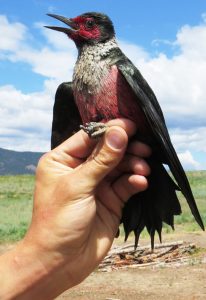
Lewis’s Woodpecker populations are declining throughout their range, but the Bitterroot and Missoula Valleys have some of the highest densities anywhere in the world. Researchers Kate Stone and William Blake from MPG Ranch, located at the north end of the valley, are in their fifth year of color banding these colorful woodpeckers, in an attempt to understand population dynamics like who mates with whom, who nests where, and if individuals come back from year to year.
Some interesting facts have turned up. The work of this pair of scientists so far has shown that though you might see Lewis’s Woodpeckers in the same area, or even tree, every year, individuals rarely return to a breeding area for more than two years, and if they do, they often use a different nest and choose a different mate. Both scientists are curious if these patterns hold true in parts of the valley other than their study site in Florence. If you would like to help in these investigations you may.
Lewis’s Woodpeckers are most easily captured when they come to a suet feeder. If you have them coming to your feeder and you’d be willing to allow researchers to visit for a few days to attempt to capture and color band them, you can contact Kate Stone at (406)381-1115 or William Blake at (406)260-2796 and let them know. A few woodpeckers will also get tiny devices called nano-tags that will register the bird’s location if they pass by one of hundreds of receiving stations throughout the USA. This information will help biologists learn where the woodpeckers migrate to in the winter and may resolve questions about how and why Lewis’s Woodpecker populations are declining elsewhere.